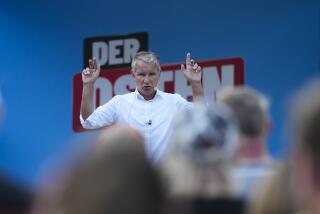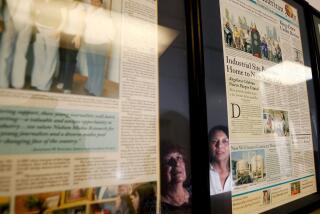Media : East Germans Dazzled by Western Press : Circulation of their own national papers has fallen 54.7% as they respond eagerly to the color and flash that was previously denied them.
EAST BERLIN â A few days before East Germanyâs first free elections last March, the West German illustrated weekly Stern announced that it would distribute its next issue, free, from a point in central East Berlin.
The result was a melee of thousands of East Germans, thirsty both for Western-style news and the novelty of the magazineâs slick presentation.
The scene was one of many that marked the start of an East German love affair with the West German press--an affair that has begun to reshape the face of publishing in both Germanys.
Indeed, there are few examples where the structure of a nationâs press has altered so drastically and with such speed.
Consider:
-- In the six months since the Berlin Wall opened, circulation of East Germanyâs national newspapers has plummeted a staggering 54.7%, with the two main Communist dailies--Neues Deutschland and its sister youth paper, Junge Welt, losing two-thirds and three-quarters of their circulation, respectively.
-- The current circulation leader in East Germany is the West German mass circulation daily Bild Zeitung--a paper whose recipe of bare breasts, political gossip and occasional genuine scoops with a not-so-gentle right-wing twist made it the former Communist regimeâs class enemy No. 1.
Bild now sells about 1 million copies daily in the East, roughly the same number as Neues Deutschland at its height. At present, every copy sold is imported from West Germany, but Heiner Bremer, spokesman for Bildâs publisher, the Axel Springer Group, says regional editions are already being planned for East German cities such as Leipzig, Rostock and Magdeburg.
âItâs a whole new kind of paper for them,â Bremer said. âIt fills a giant hole in the market.â
-- The former East German post office newspaper distribution monopoly collapsed early this year and was replaced by a group of four major West German publishers, who simply carved East Germany into quarters and have operated as general distributors.
A new system is being organized that will divide the ownership between East and West German interests.
-- Nearly 300 West German daily and weekly publications now circulate in East Germany, while the old gray-on-gray look that once marked East German publications has begun to disappear in the colorful fight to remain competitive.
Told that his revamped TV weekly magazine looked exactly like a West German product, senior East German publishing executive Lothar Popp smiled and said, âThatâs the idea, isnât it?â
Major West German publishing houses have also moved quickly to buy into East German publishing groups that see Western help vital for their survival.
Springer, for example, has a stake in eight East German newspapers and expects to invest $250 to $300 million âin the next few yearsâ in East Germany. The high-brow Frankfurter Allegemeine Zeitung has bought into a chain of five East German papers that previously belonged to the Christian Democratic Party.
West German magazine publishing giants such as Bauer Verlag and Gruener & Jahr, have moved for the first time into the newspaper field by forging linkups with smaller, regional East German papers.
(Some West German newspaper publishers see it as the start of a more grandiose, âbackdoorâ strategy to get into West German newspaper publishing.)
Non-German publishers have also become involved.
Robert Maxwell, who owns Britainâs Mirror Group Newspapers, has signed a letter of intent to purchase a sizable stake in one of East Germanyâs largest publishing houses, the Berliner Group.
The East Berlin-based group has a stable of properties with a combined circulation of about 5 million, including the East German capitalâs most important paper, the Berliner Zeitung.
The result of this invasion from the West will accelerate the overhaul of what until eight months ago was arguably the most stringent and doctrinaire of all the Communist-controlled media.
âThe Hungarians could report fairly freely even before the end of communism there,â Bremer said. âThey too will look west for a tradition of greater freedom of expression, but neither they nor anyone else can possibly match the intensity that is here. We are also German talking with German.â
While the language may be the same, the outlook between East and West German frequently is not.
Nearly half a century of separation has left the two Germanys with outlooks and expectations often as sharply opposed as the political systems under which they once lived.
Nowhere is this gap more visible than in the press.
East Germans may have viewed West German television for the better part of two decades, but West German newspapers are a totally new experience.
Even such basics as the number of pages in a paper tends to separate two cultures that for much of the past 40 years have been at opposite ends of the consumption scale.
âAn East German is just overwhelmed with our Saturday edition (which frequently runs over 100 pages),â noted Monika Zimmermann, the East Berlin correspondent of the Frankfurter Allegemeine Zeitung, who has been named to take over as editor of Neue Zeit (New Times), one of the paperâs East German acquisitions. âItâs just too much newspaper and, anyway, it doesnât fit in the mailbox.â
Until last Novemberâs revolution, most East German papers rarely exceeded eight pages.
J. Walter Thompson executive Eilika Emmerlich recalled East German reader outrage at the waste of precious space when a West German auto maker splashed an ad across two full pages.
âFor us in the West, it was a beautiful layout with lots of white space, but for an East German who couldnât get his own personal supply of paper because it was in such short supply, it was a tragic waste of space.â
The clash of such traditions, coupled with a news bias of West German papers toward their own home regions, has led Western publishers (with the exception of Bild) to view East Germany more as a market ripe for acquisition than expanded circulation.
Here, West German influence may be less visible, but it will also be considerable in helping the development of a free, aggressive press in a region where free thought has been numbed by nearly 60 years of back-to-back Nazi and Communist dictatorships.
The majority of West German publishers say they plan to import advisers for their East German media acquisitions but keep most of the existing staff members, even though they have turned out little more than government propaganda sheets for decades.
For East Germans, the learning experience in such areas as advertising and computer technology is demanding.
But West German publishers say the hardest task of all is teaching reporters and editors to think independently.
âThey have to develop the courage to have their own opinions, and we can only do that by example,â Zimmermann said.
Added Bremer: âTeaching the new (computerized) technology will be easy; the hard part will be tearing down the internal walls--the walls in the mind that block free thinking.â
More to Read
Sign up for Essential California
The most important California stories and recommendations in your inbox every morning.
You may occasionally receive promotional content from the Los Angeles Times.










